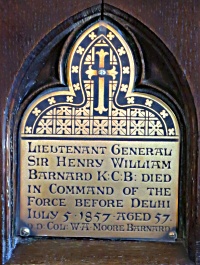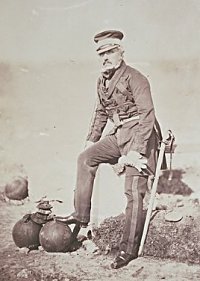The plaque is on the back of one of the choristers stalls in the chancel.
South side, back row, eleventh from the west end.

Portrait

Photo by Roger Fenton
SIR HENRY WILLIAM
BARNARD K.C.B. DIED
IN COMMAND OF THE
FORCE BEFORE DELHI
JULY 5 1857 AGE 57
DD: COL.W.A.MOORE BARNARD.
Further Information
Sir Henry William Barnard was born in 1798 at Wedbury, Oxfordshire. His father was Revd. William Barnard of Water Stratford, Buckinghamshire. He attended Westminster School, and from there went on to the Royal Military College, Sandhurst. He graduated in 24 June 1814 and joined the Guards as lieutenant in June 1814. By August 1822 he had risen to the rank of Captain and married on 17 January 1828 Isabella Letitia, second daughter of Brigadier-General James Catlin Craufurd; she survived her husband.
By 1831 Barnard was a Lieut. Colonel and had served some time in Jamaica. He was on duty during the coronation of Queen Victoria on 20 June 1837. In April 1838 he sailed with the battalion from Portsmouth for service in Canada, returning with it to London in November 1842. He then held a number of staff posts in England until the outbreak of the Crimean War when he was appointed to the command of a brigade of Lieutenant-General Sir Richard England's division. He was promoted major-general on 20 June 1854. Following the death of Field Marshal Lord Raglan, the army commander, in June 1855, Barnard replaced Raglan's successor (Lieutenant-General Sir James Simpson) as chief of staff, and after the fall of Sevastopol commanded the 2nd division. He was appointed KCB on 3 May 1856, and became a commander of the Legion d'honneur (third class) and commander of the military order of Savoy (first class).
In 1857 Barnard was sent to India to take over the Sirhind division. On 10 May news came of the outbreak of the Indian mutiny in Meerut and Delhi. A fortnight later the commander-in-chief, General the Hon. George Anson died of cholera and Barnard took charge of the field force ordered to relieve Delhi. At Alipur, 10 miles from Delhi, on 5 June, Barnard halted to await a brigade from Meerut. Three days later he defeated a rebel force at Badli-ki-sarai and that evening took possession of an extended ridge overlooking the north-west of the city. In acting so decisively he had secured lines of communication for reinforcements and supplies, and immensely raised morale by recapturing the cantonments from which British troops had been driven a month previously.
On 10 June the acting commander-in-chief, Major-General Thomas Reed, arrived to supersede him, but soon fell ill, and direction of the siege devolved on Barnard. Despite repulsing enemy forays and himself sending parties successfully to destroy rebel batteries, postponement of a planned attack on 13 June and repeated delays in its subsequent execution suggested irresolution. In fact, with a maximum 4500 men and 44 guns, Barnard had to devise very carefully a means of overcoming an estimated 30,000 rebels with 174 guns. Barnard was accused of 'Fearful indecision and want of firmness (which) made him [Barnard] unfit for his position'. In fact Barnard was a convenient scapegoat to cloak over-optimism represented by Governor-General Greathed's assertion that 'we seem to have Delhi by the nose', announcing in a dispatch of 4 July that it had already fallen.
Barnard fell ill with cholera on 4 July 1857, before arrival of the reinforcements which might have allowed him to silence his critics, and died the following day. Fearing an enemy attack, his last words in delirium were allegedly 'strengthen the right'. In spite of the damning strictures of his detractors, he had laid the foundation fot the eventual relief of Delhi and, by his swift advance and initial military successes, had gone far towards restoring British prestige in the area. Barnard was buried on 6 July 1857 in the Rajpur cemetery of the cantonment outside Delhi, his wooden coffin accompanied by an escort of Lancers.
Barnard's name appears, alongside nine others on the memorial that stands outside Westminster Abbey to the former pupils of Westminster School who fought in the Crimean War. The section referring to Barnard reads:-
General Sir Henry William Barnard, Commander in Chief 1857
General Barnard was buried at Rajpur Cemetery, Delhi. The inscription on his grave reads:-
Beneath this cross are buried the mortal remains of
Major General Sir Henry Barnard K.C.B.
who died the VIIth July MDCCCLVII
when in chief command of the troops
besieging Delhi
This monument is erected to his memory
by brother officers who served with him before
Sebastopol
[From information supplied by the descendants of General Barnard]
Addendum
Some additional information concerning the plaque in the Garrison Church has been sent in by Fabian Robertson, the great great grandson of Sir Henry Barnard. This consisted of two letters written by Archdeacon Henry Press Wright and addressed to General Barnard's son Colonel WM Barnard on 24th May and 2nd June 1871. In them Wright suggests that the Colonel might be interested in sponsoring a plaque at the church in memory of his father. He quotes a fee of £15, which if typical, represents a total amount raised of £570, a not inconsiderable sum. This is the only evidence we have of the sponsorship process adopted by Wright.
See also
Wikipedia
The BBC website for more information on the Indian mutiny, and,
http://defencejournal.com/nov99/pol-mil-situation.htm for information about the political and military background in India in 1857
